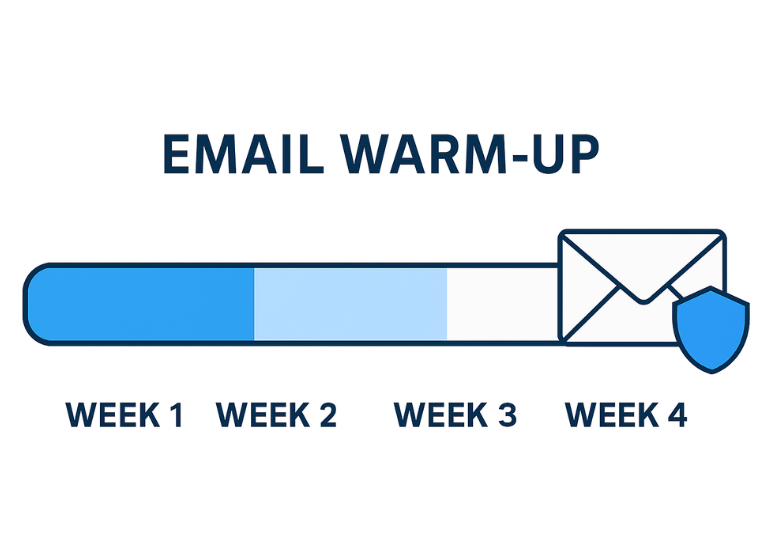Why Your First Cold Email Send Can’t Happen Tomorrow
Setting realistic timelines for new domains, cold data and deliverability
When you’ve just signed off creative, approved targeting and agreed a strategy, it’s natural to want your first email campaign to go out as soon as possible.
But if you’re using a brand-new sending domain and emailing cold data, “as soon as possible” is rarely “tomorrow”.
In this post, we’ll walk through why a four-week warm-up is often the most sensible, effective route, how inbox providers view new senders, and how Emailmovers protects your brand by using separate campaign domains.

Why new domains and cold data need a different approach
When you launch a campaign from a brand-new sending domain to a list of cold prospects, inbox providers like Microsoft and Google don’t have any sending history to work with yet.
From their point of view, a new domain suddenly sending large volumes of email is something to examine more closely. If you increase volume too quickly, inbox providers may respond cautiously, which can mean:
- Temporary slowing of sends (throttling)
- More messages being filtered or routed to secondary folders
- Less predictable bounce and engagement patterns
This is exactly why we use dedicated campaign sending domains rather than your main, “precious” brand domain. It’s a standard best practice that:
- Keeps your primary brand domain completely separate from cold outreach
- Gives more control over how we build sending reputation on the campaign domain
- Allows us to manage volume and performance in a structured, measured way
A planned warm-up period isn’t about avoiding catastrophe – it’s about giving a new campaign domain the best possible introduction, so future sends can run more smoothly and consistently.
How inbox providers judge your sending behaviour
Inbox providers don’t just look at what you send – they pay very close attention to how you send it. Some of the things they care about:
Consistency of sending patterns
A steady, predictable pattern of email activity is a positive signal. Sudden spikes from a brand-new domain are more likely to be treated cautiously.
Engagement signals
Opens, clicks, replies and forwards all help demonstrate that people are interested in your emails.
Negative signals
Hard bounces, spam complaints and “delete without reading” behaviours are signs that something may not be right. A warm-up plan is simply a way of introducing your new campaign domain gradually, in a way that gives inbox providers confidence rather than reasons to hold back your messages.
A practical four-week warm-up plan
Here’s an example of a sensible warm-up schedule for a new campaign domain sending to cold data of around 10,000 contacts:
Week 1
- Send: around 50 emails per day, Monday to Friday
- Goal: Establish an initial sending pattern and check for any early issues
Week 2
- Gradually increase daily volume (for example, 100–200 per day), still Monday to Friday
- Goal: Build familiarity with inbox providers while closely monitoring performance
Week 3
- Continue stepping up volume (for example, 300–600 per day)
- Goal: Strengthen sending reputation as engagement and delivery data builds
Week 4
- Increase towards and beyond 1,000 emails per day
- Goal: Reach the full list of approximately 10,000 contacts by the end of the week
By the end of this four-week period, the domain has a solid sending history, inbox providers have seen consistent, controlled behaviour, and you’ve reduced the chances of unnecessary filtering or throttling.
It’s slower than hitting “send to all” on day one – but it gives your campaign a much better chance of reaching inboxes reliably.

Protecting your “precious” domain
For many brands, the main website and email domain is a valuable asset:
- It’s used for day-to-day business communication
- It appears on invoices, proposals and contracts
- It often carries years of established sender reputation
For that reason, Emailmovers does not use your main domain for managed cold campaigns at all.
Instead, we:
- Set up dedicated campaign domains specifically for outreach
- Authenticate and configure those domains correctly (SPF, DKIM, DMARC, etc.)
- Warm them up carefully before any large-scale sending
This approach:
- Keeps your everyday email traffic and your cold outreach completely separated
- Ensures your day-to-day business email is not affected by campaign testing or volume changes
- Gives you more flexibility in how you scale and refine cold email activity over time
In other words, we use new domains as a protective layer for your brand: your core domain stays out of the firing line, while the campaign domain is managed, monitored and nurtured by our team.
What happens after the warm-up?
Once the warm-up is complete and the campaign domain has built a positive sending history, you’re in a much stronger position to move quickly.
- Email 1: sent as part of the warm-up over four weeks
- Email 2: can often be sent in a single day to the full, warmed-up list
- Emails 3 and 4: can follow in subsequent weeks, depending on your strategy and performance data In other words, the warm-up is the careful, methodical part. Once that’s done, later sends can move at the pace you originally had in mind – with far greater confidence around deliverability.
Communicating timelines internally: expectations and stakeholders
From a marketing or sales perspective, a four-week warm-up can feel like a delay. Internally, you may be asked questions such as:
- “Why can’t we send to all 10,000 contacts next week?”
- “Are we losing momentum by waiting?”
- “Can’t we just go ahead and send everything at once?”
Having a clear explanation ready helps. You might frame it like this:
- We’re protecting a valuable asset (your brand and domains) by building a clean, steady sending history.
- We’re improving the chances of hitting the inbox, rather than being filtered or sidelined.
- We’re prioritising long-term performance, not just a one-off spike.
When stakeholders understand that the warm-up is how you protect their investment in data and creative, it becomes much easier to get buy-in.
How Emailmovers supports this process
At Emailmovers, we combine three things:
- Quality data: carefully sourced and maintained business data
- Technical setup: including dedicated campaign domains and platform configuration
- Managed campaigns: creative, delivery and optimisation handled by an experienced team
That includes:
- Setting up and warming dedicated campaign domains (not your main domain)
- Hosting and checking creatives before launch
- Structuring a warm-up that fits your list size and objectives
- Monitoring delivery, opens, clicks and complaints throughout
The result is a more controlled, measured path into cold email – one that supports both performance and brand protection.
Final thoughts
If you’re planning to email cold data from a fresh domain, a controlled warm-up isn’t a delay for the sake of it – it’s the foundation that everything else rests on.
- It protects your brand and core domains
- It improves your chances of landing in the inbox
- It gives you time to monitor performance and adjust It creates a more sustainable approach to acquisition
It may not be as immediate as “send to all tomorrow”, but it’s a far better way to get consistent results from your investment in data and email.
Get In Touch With Us!
Call us on 01723 800030
